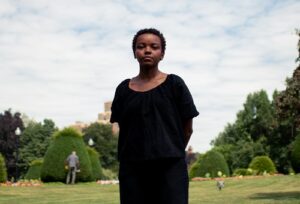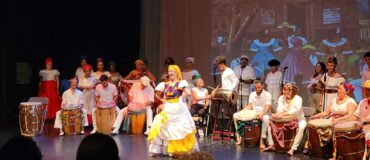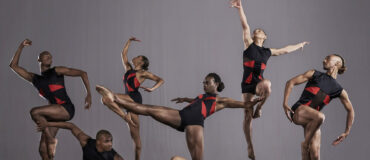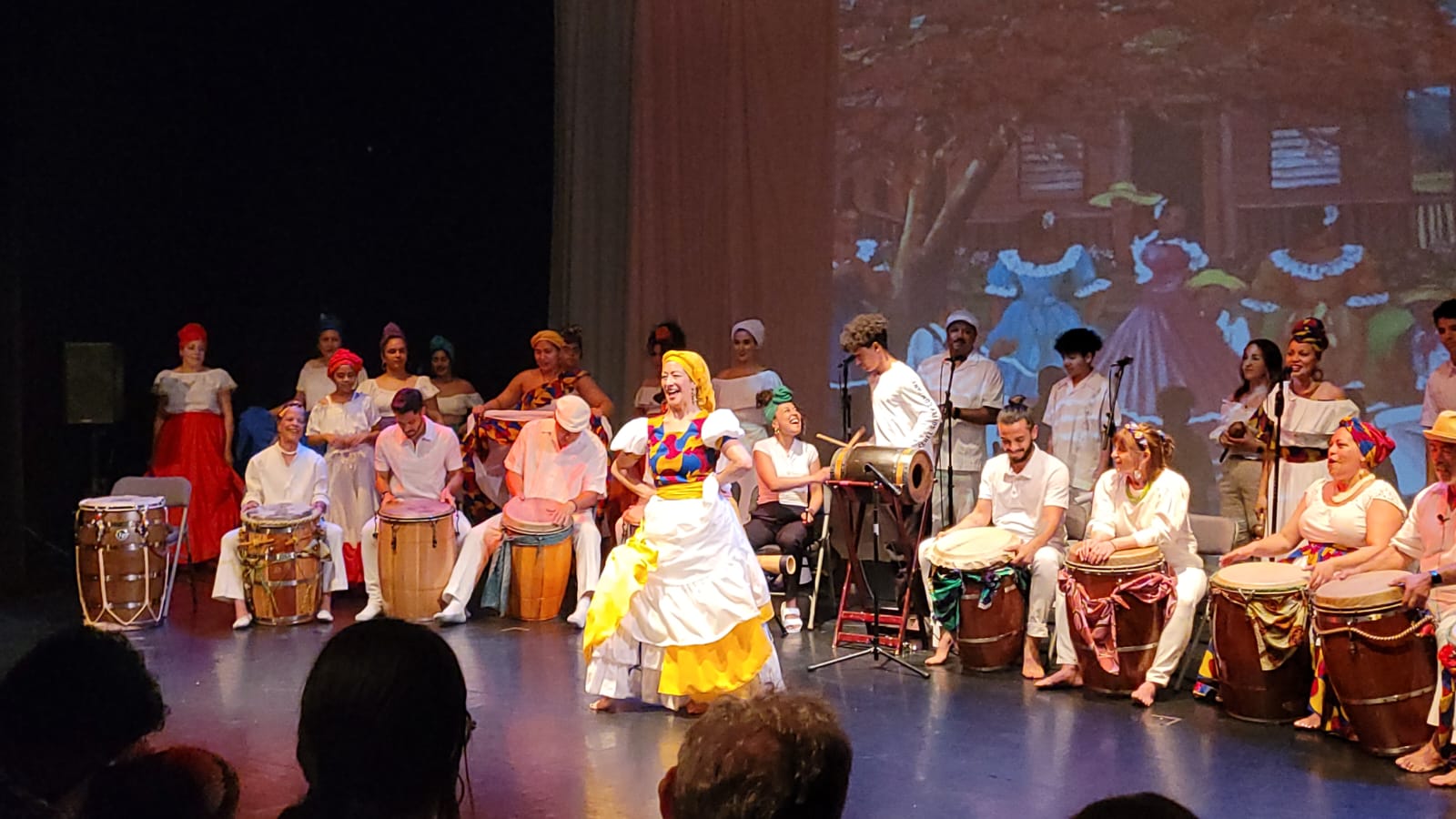Archiving Fellowships Blog: Jennifer Harge/Harge Dance Stories, Part 3
By Laila Franklin
Laila Franklin is a 2023 Archiving and Preservation Fellow with Jennifer Harge/Harge Dance Stories. Read more about the Fellowships here. This is the third and final part of Laila’s blog; read the second part here.
Alternative Approaches to Archiving
My introduction to archiving was not traditional. As a dancemaker, my archiving practice often consisted of organizing reference documents, personal notes, and performance documentation to access them for future processes easily. This manifested as expandable folders and spreadsheets. On a project-to-project scale, I often found myself creating even more intricate systems of organization, focusing on the content of the notes and reference documents themselves, creating visual maps depicting webs of information to understand the scope of a project better.
When beginning this project with Jennifer Harge/Harge Dance Stories, we shared a goal of finding a way to lean into my less traditional archiving approaches and supplementing them with more formalized organizational approaches. Through collaboration, we formalized a creative system that honored a multidisciplinary approach to dancemaking partnered with an organizational approach that honored clarity and utility.
Inventory

Collaborator Devin Drake photographs archive materials
An early step in archival inventory is organizing the content of your collection by material type. The collection I worked with was entirely made up of process notes. Because the material itself was all the same but the content varied greatly, my first step was to determine distinct content categories to group them by. The categories we chose reflected larger ideas or themes that were present in singular lines or on entire sheets. Some of those categories included “declaration,” “place/placemaking,” and “citation.” We assigned each category a corresponding color and marked each sheet with Post-it notes the color of the categories present. We took multiple passes at the collection to make sure we felt happy with the assigned categories. As I had more conversations with Harge throughout the process, sometimes she would highlight something on a sheet that would bring a new category to our attention, or we would notice a pair of categories constantly appearing together and find a way to make them into a singular category. We would go on to call these categories “tags” once we logged them into our Airtable chart.
Descriptions, Transcriptions, Footnotes
Following this organization, I went through each page and wrote a brief description outlining what would be found on each sheet, using the categories as keywords within. I worked closely with Harge to complete this task, as it required both a close knowledge of the content of the sheet and concise language to very briefly describe often complicated thoughts. I took one pass at all of the sheets and then sent my notes to Harge to be reviewed and finalized. She added in any context I may have missed and clarified any ideas.
When approaching transcription, our archiving mentor, Marcia Black, reminded me to consider the utility of the transcriptions – who are they for and what purpose do we see them serving in the future? Because this project will serve as a reference point for a larger writing project in the future, I approached transcriptions as a way to make the handwritten text legible and maintain the spatial orientation of the text on the paper. After completing the first round of this, I consulted Harge to make sure I maintained what was important on each sheet – do we need to use a dash versus an arrow? How important is it that I circle or underline this word? Does capitalization matter here? Would you prefer the spelling to be corrected? With these kinds of guiding thoughts and questions, we created descriptions that would be helpful when revisiting the archive in the future.
Later in the process, we decided to add an element to our archive we called “footnotes.” These brief statements were meant to capture the essence of each sheet from a slightly more poetic and creative approach. In our minds, if this archive becomes public-facing, this footnote would be the most prominently featured text available to readers, acting as a more meditative entry into the content of the sheets.
Organization for Future Use
We were introduced to our organizational software, AirTable, by our archiving mentor. The beauty of Airtable is that it is a project management software. It is highly customizable, allowing us greater flexibility in the ways we want to organize the content of our archive. Thinking back to the notion of utility, we created categories for all of the information that would be useful to know for future use. This included identification numbers, photographs, descriptions, tags, footnotes, and additional notes for context. The additional notes came from Harge and collaborator Miryam Johnson, adding further context to the archived material.
In addition to our AirTable database, we developed a map of our paper organization. This creative approach grew out of an interest in a note-taking method I employed for myself while organizing the physical papers for tagging. We kept the idea of the map with us throughout the organization process and found the physical layout of the papers useful when thinking about the ways that movement could be present in an archive. The map of the papers, paired with the footnotes, acted as a score to explore the conceptual space that the project put forward, creating an exciting and fruitful new way of connecting to and exploring the archive we created together.
Header image: Photo by Kirk Donaldson. Pictured: Jennifer Harge leading University of Michigan Dance students in Harge’s “Studio A, will you die with me?” (Ann Arbor, MI 2019)
All other photos courtesy of the author.
 Laila J. Franklin (she/her) is a dance maker, performer, teacher, administrator, and writer based in the unceded territory of the Massachusett and Pawtucket peoples (Boston, Massachusetts.) Her work extends from lineages of Black queer experimental dance makers, with a particular interest in postmodern improvisatory practices and aesthetics, and dance theater. In her work, she explores kinetic imagination through the rigor of juxtaposing virtuosic and intimate performances, seeking to make legible the (in)visibility of lived experience. Her performance/collaboration credits include work with Miguel Gutierrez, Melinda Jean Myers, Dr. Christopher-Rasheem McMilland, and Ruckus Dance. As a Fellow, Laila is looking forward to collaborating with Jennifer Harge/Harge Dance Stories to explore ways to bring further legibility to an embodied and culturally citational body of work, taking experiential approaches to transfer bodily archives to physical archives. Laila holds an MFA in Dance from the University of Iowa and a BFA in Contemporary Dance Performance from The Boston Conservatory. Photo credit: Bailey Bailey.
Laila J. Franklin (she/her) is a dance maker, performer, teacher, administrator, and writer based in the unceded territory of the Massachusett and Pawtucket peoples (Boston, Massachusetts.) Her work extends from lineages of Black queer experimental dance makers, with a particular interest in postmodern improvisatory practices and aesthetics, and dance theater. In her work, she explores kinetic imagination through the rigor of juxtaposing virtuosic and intimate performances, seeking to make legible the (in)visibility of lived experience. Her performance/collaboration credits include work with Miguel Gutierrez, Melinda Jean Myers, Dr. Christopher-Rasheem McMilland, and Ruckus Dance. As a Fellow, Laila is looking forward to collaborating with Jennifer Harge/Harge Dance Stories to explore ways to bring further legibility to an embodied and culturally citational body of work, taking experiential approaches to transfer bodily archives to physical archives. Laila holds an MFA in Dance from the University of Iowa and a BFA in Contemporary Dance Performance from The Boston Conservatory. Photo credit: Bailey Bailey.
____
We accept submissions on topics relevant to the field: advocacy, artistic issues, arts policy, community building, development, employment, engagement, touring, and other topics that deal with the business of dance. We cannot publish criticism, single-company season announcements, and single-company or single artist profiles. Additionally, we welcome feedback on articles. If you have a topic that you would like to see addressed or feedback, please contact communications@danceusa.org.
Disclaimer: Opinions expressed in guest posts do not necessarily represent the viewpoints of Dance/USA.






